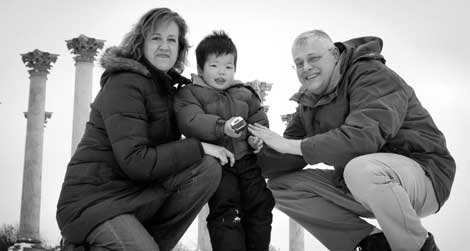What to Eat When You’re Adopting
Eating bulgogi for three: If we knew little about Korean cuisine, boy, we knew even less about parenting
/https://tf-cmsv2-smithsonianmag-media.s3.amazonaws.com/filer/20110526093007bi-bim-bap-korean-food.jpg)
Eating Bulgogi for Three
By Amy Rogers Nazarov
Churning a fried egg into bee bim bap at a Korean restaurant on a frigid night in early 2007, I tried to imagine the face of my future son.
My friend Laura was showing me how to christen the dish—a bed of white rice topped with wedge-shaped dollops of crispy sprouts, julienned carrots, spinach leaves and shreds of marinated beef—with a blob of spicy red bean paste called gochujang.
“Now we mix it all together,” she said, digging down into the bowl to ensure every rice grain and vegetable shard got coated. She turned over a bit of crispy rice from the bottom of the hot pot. “See the crust the sesame oil forms?” She took a bite. “Isn’t it amazing?”
She was referring to the meal, which tasted homey and exotic at the same time. Yet what I found most amazing as I chewed was that my husband and I would travel to Seoul within the year to meet our baby—the person we’d feed, diaper, bathe, protect, adore and see into adulthood.
The year prior to my bee bim bap initiation, Ari and I had begun the process of adopting a child from South Korea. Late in 2007, we finally saw his face in photographs.
Taewoo’s hair stood straight up. He had a strawberry birthmark on his shoulder. In some of the photos, he was embraced by his foster mom, who beamed at him. We placed the pictures in resealable plastic bags and pored over them too many times to count, as though we could divine from them clues about what he might be like.

The Nazarov family (Amy, Jake and Ari) at the National Arboretum in Washington. Credit: Jose Rodriguez
If we knew little about Korean cuisine, boy, we knew even less about parenting. How would we know what Taewoo—whom we intended to call Jake, preserving the name his birth mom gave him as his middle name—wants when he cries? What if he throws up in the grocery store? What if we can’t get him into that great local preschool? How on earth will we—two Caucasians– teach him to respond to subtle or overtly racist comments? What if Jake turns 18 and buys a one-way ticket to Seoul, claiming he’s off to find his “real” parents?
We had no idea how we would respond to any of these situations. But dining out? That we were aces at.
“Daddy and I used to eat kimchee like it was going out of style,” I pictured myself telling Jake. “We wanted to learn everything we could about you, or at least the place where you came from.”
So Ari and I crunched through beet-dyed lotus root at another D.C. restaurant, named after a Korean dumpling served steamed or fried. The magenta-hued tuber was part of the banchan—an assortment of shared appetizer-like dishes—served before the main meal in virtually every Korean restaurant. They range from tiny whole fish redolent of the sea to chopped, sautéed eggplant to several grades of kimchee: hot, extra-hot, and throat-melting. Everything demanded to be tasted, even when its burn forced you to croak out a plea for ice water. Perhaps every bite would help us understand Korea—and by extension, the child in the photos—a fraction more.
Sometimes friends who’d adopted came along. Sarah and James’ daughter was born in Korea, and at one place in Maryland, just over the District line, I watched Tara pluck buckwheat noodles from her plate of naengmyeon one at a time, dangling them over her mouth, laughing as they flopped against her cheek.
“We tried to imagine the sound of your voice,” I would tell our child. “We talked about which restaurant we’d take you to first.”
Even as massive amounts of paperwork remained and references were yet to be collected, we took my parents to still another Korean restaurant, this one in Virginia, to introduce them to bulgogi and chapchae. We talked about the logistics of their meeting the three of us at Dulles airport when we returned from Seoul. We brainstormed how to make Jake feel safe with us, the strangers chosen to parent him.
In February 2008, Jake came home, and proceeded to prove himself a very good eater.
Today he has a taste for kimchi and a passion for noodles. I’ll never know if this is genetic, or because every single night when he was 2 years old, we read the book Bee-bim Bop! by Linda Sue Park. Maybe it’s partly due to repeated exposure to the foods of his birth country, where I picture us three eating abalone porridge (jeonbokjuk) one day when he’s in his teens. But travel plans will have to wait; it’s dinnertime.
“More, please,” says my boy, polite as a prince when a cheese pupusa or his grandmother’s meat loaf is on the line, as naughty as any almost-four-year-old when he’s not angling for more to eat. “More, please, Mama.”